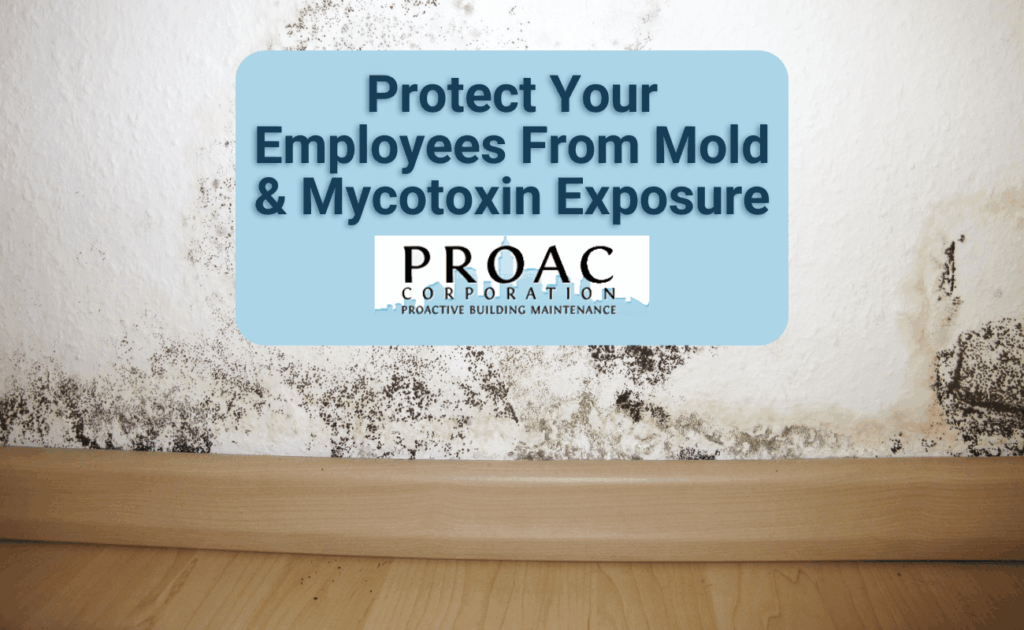Most employees don’t give mold or mycotoxins much thought when working in your office, shop, or plant. These unseen risks have the potential to gradually accumulate and result in major problems for productivity and health. Although moisture or dust might seem like small annoyances, they can provide the ideal conditions for the growth of mold, and when mold flourishes, harmful mycotoxins frequently follow. Proactive facility management and preventative measures are necessary to protect your staff from mold and mycotoxins.
Why Mitigating Mold & Mycotoxins Is Important For Your Staff
Not only does mold look ugly and turn away customers and but it also directly affects indoor air quality and worker health. The harmful byproducts that some molds produce are called mycotoxins, and they are especially dangerous. For sensitive people, prolonged exposure to mold spores or mycotoxins can result in respiratory irritation, persistent coughing, allergic reactions, and even more serious health issues. In addition to the health risks, companies that ignore mold problems risk legal action if workers can demonstrate that their illnesses were caused by hazardous working conditions. To put it plainly, no business should take the chance of neglecting mold.
What Happens When You Don’t Consider Mold & Mycotoxins’ Impact On Employees
When mold and moisture are not controlled, employees and customers who visit your building are the ones who suffer. Poor indoor air quality brought on by mold can be linked to even relatively minor issues like recurrent colds, sinus infections, or flare-ups of asthma. In more severe situations, mycotoxin exposure has been linked to long-term respiratory illnesses and neurological problems. Employees who work in unhealthy environments miss work or find it difficult to give their best effort, which lowers productivity. Mold issues can develop into a serious health and liability problem for any facility if they are not addressed.
How To Protect Employees From Mycotoxins & Mold
Don’t Let Dust Accumulate And Create Spores
Dust may appear harmless, but it can hide mold spores when it accumulates in carpets, corners, or behind equipment. These spores have the potential to be disturbed and recirculated into the daily air that your employees breathe. To stop mold from growing inside your building, you must regularly clean it and pay attention to areas that are prone to dust.
Use High-Efficiency Particulate Air (HEPA) Filters And Equipment
While visible dust may be removed by standard vacuums and filters, fine particles and spores are frequently released back into your building’s atmosphere. Even the tiniest pollutants are guaranteed to be caught and contained when a HEPA vacuum is used. This keeps your workplace air cleaner and safer for workers while significantly lowering the chance of mold spores spreading.
Avoid The Buildup Of Moisture
The most crucial element for the growth of mold is moisture. Uncontrolled humidity creates the ideal conditions for mold growth. Common errors include turning the thermostats too low, which can result in condensation problems, or too high, which permits humidity to accumulate. In both cases, the building becomes overly wet. When you combine that with humid or rainy weather, mold issues are inevitable. Preventing mold and mycotoxin exposure requires keeping an eye on your HVAC system and maintaining constant indoor humidity levels.
Keep Your Employees Safe From Mold & Mycotoxins With The Experts From PROAC
At PROAC, we understand the risks of mold and mycotoxins and have what it takes to find mold problems in your facility and remove them. For mold air quality testing, mold remediation, mold prevention, and other important property maintenance services, choose the expert team from PROAC. Contact us for a free quote, and start protecting your employees from mold and mycotoxins today.

